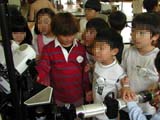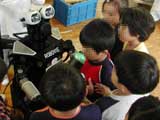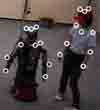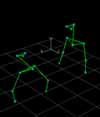| Experiment |
Elementary School Experiment
We carried out an experiment to investigate the possibility of having active humanoid robots in a human society in the future. In this experiment, Robovie plays a role similar to a foreign student who just transfers to a Japanese elementary school. With such a 'foreigner' who speaks English only, we attempt to see the interaction between children and the robot.After the first graders and sixth graders each participated in the experiment for two weeks, we obtained the following results: During the first week, the children played with the robot actively. Through the interaction with robots, the children's English listening skills were developed. On the other hand, after interacting for a week, most children's excitement seemed to have satiated. This is a problem that we have to face if we want to develop robots that are applicable in human society. It turns out that there are still a lot of studying areas that require further research.
Interactive Robots as Social Partners and Peer Tutors for Children: A Field Trial
(Human Computer Interaction, 2004.)
Snapshots taken during the experiment



